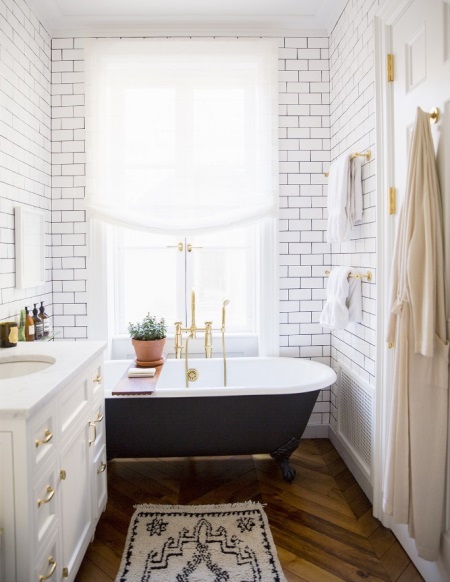Bathroom tiling - 112 photos
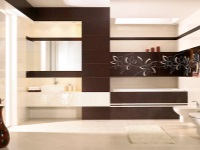
Tile is the most popular option for tiling the bathroom, but choosing it is not as easy as it seems at first glance. Let's figure out together what type of tile trim is right for your bathroom.
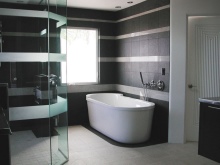
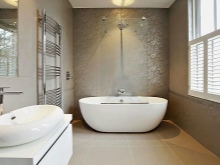
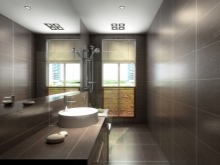
Tile Types
All tile is divided into several types according to the method of manufacture.
1. "Bicottura" - double-fired tiles with a glazed surface. Suitable for finishing walls, but not suitable for floors.
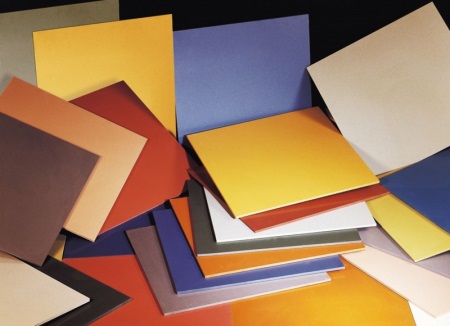
2. "Monocottura" is a single-fired tile, which makes it durable and can be used as a floor covering.
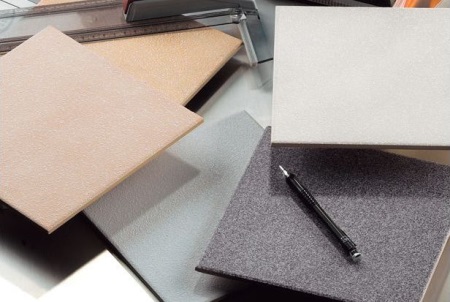
3. Clinker tile is the most durable and therefore the most popular. It is made by special technology and is often available in its natural red-brown color. It is usually used for floor cladding.
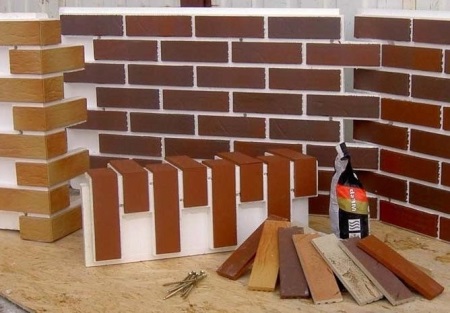
4. Mosaic is a special type of tile that does not require laborious assembly. Mosaic tiles are already glued on a grid and are sold in a roll on the principle of wallpaper. Therefore, its laying is quick and does not require any special skills.
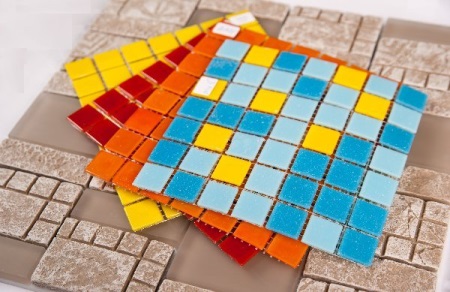
5. Porcelain stoneware is an artificial material that imitates a slice of granite or marble. An excellent budget replacement for natural materials.
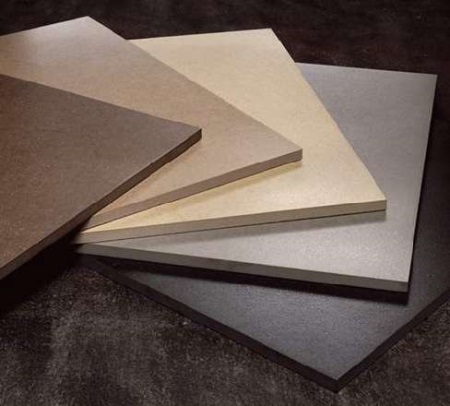
6. Mettlach tiles are a very durable double-fired material, made from quarry clay with a superior composition. Ideal for wall cladding.
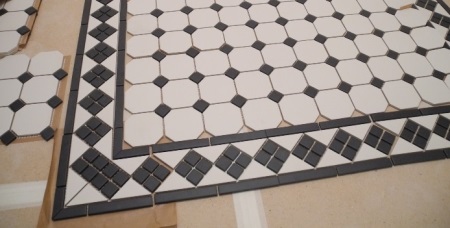
7. Glass and mirror tiles are used to finish walls and ceilings. It is durable and moisture-resistant, but it is afraid of any mechanical impact.
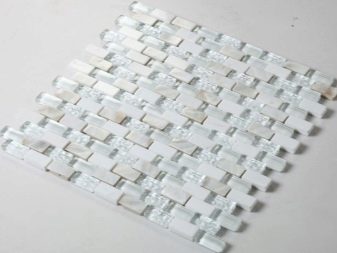
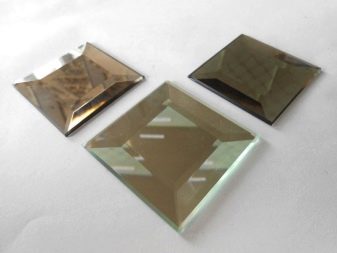
What is finished with tiles?
Walls
Facing the walls with tiles in the bathroom is the most common option. There is not only a huge selection of tiles for every taste, but also various inserts, borders, panels and other decorative elements. This is a very durable material that will last you a very long time. That is why you need to choose tiles responsibly so that they will continue to please your eyes after years.
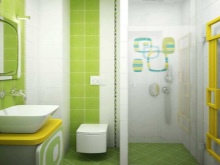

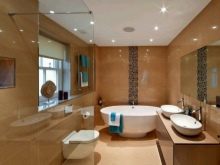
Floor
A special, non-slip tile is used to cover the floor. This is an excellent moisture-resistant coating that is easy to clean. The most common options - ceramic tiles, porcelain tiles and mosaics, which are durable and attractive appearance.
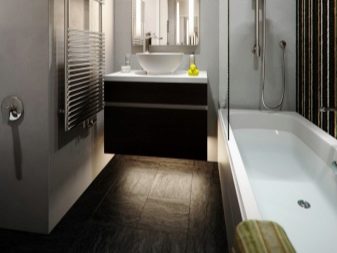
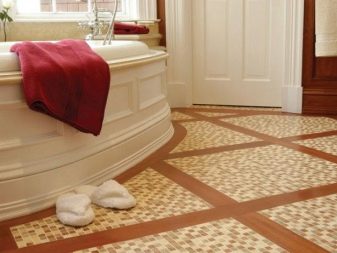
Ceiling
The use of ceiling tiles is not very common, but it is this type of finishing gives the bathroom a rich and original appearance, it looks stylish and modern.
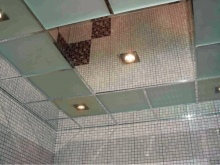
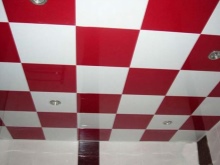
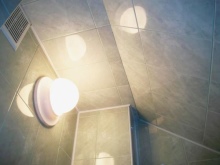
The most expensive, but reliable, is considered extruded tile. It is available in a large variety of colors and sizes, so it is easy to choose the right option. It has a smooth surface, so it is easy to wet cleaning.
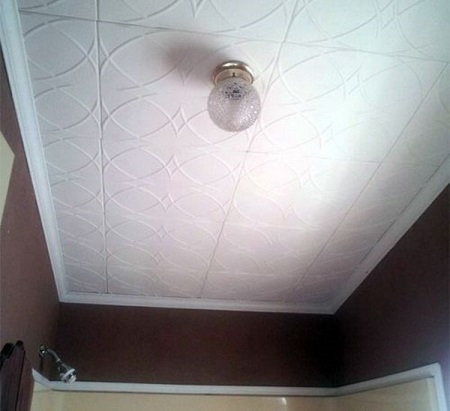
Tabletop
The countertop allows not only to increase the useful area in the bathroom, but also to improve its functionality. It is an indispensable part of the modern interior, which gives the bathroom a respectable appearance.
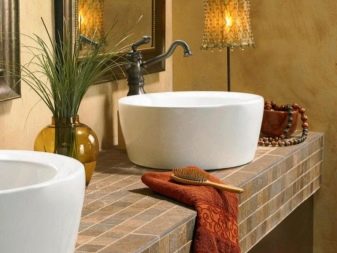
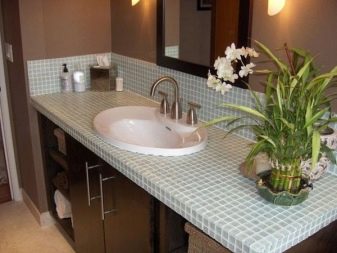
The optimal option for the supporting structure is plasterboard, which is subsequently tiled with tiles, mosaic or porcelain stoneware. Usually the same material is used to finish the walls and the countertop. This is an inexpensive and quick way to install a countertop under the sink, which will dramatically transform your bathroom.
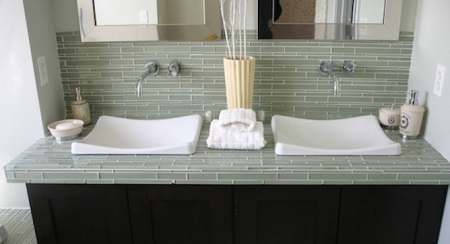
Bathtub Bottom
The open space under the bathroom looks completely unsightly, so most often it is covered with brickwork or plasterboard, and then tiled.
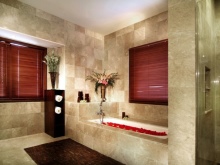
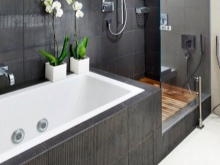
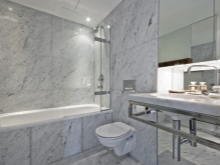
Especially effective look set compositions of mosaics, which smoothly pass from the floor to the bathtub and vice versa. In principle, for this you can also use tile, as a more budget option.
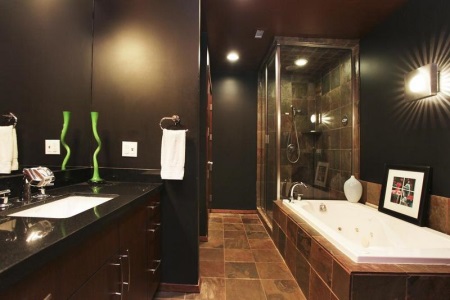
Combined options
With painting.
Painting the walls is the easiest, fastest and cheapest way to transform the walls in the bathroom. And if you combine tiling with painting, you will also get a very practical option.
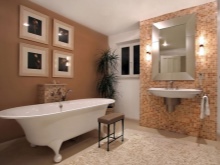

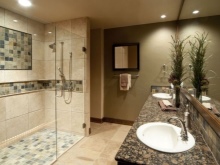
Usually the tiles are laid up to the middle of the wall or 1/3 of the floor, and above that the painting begins. Often, the tiles laid in this way, smoothly passes into the floor tiling, which looks even more harmonious.
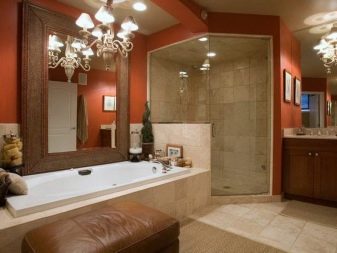
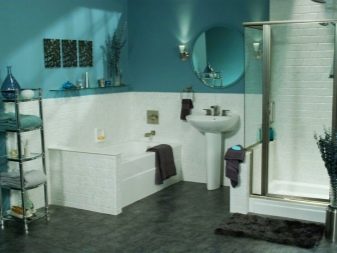
With wallpaper
Wallpaper can not be called a practical option for the bathroom, but in combination with a tiled finish, you can get a very worthy option. For example, you can tile only the shower cabin or the space around the bathtub, and wallpaper the remaining walls.
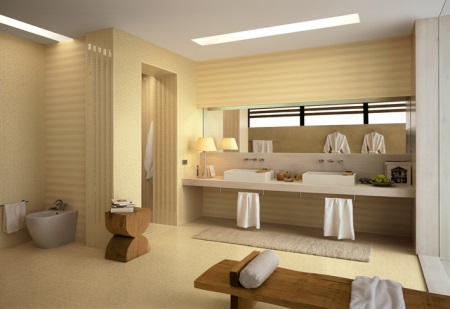
It is better to use special wallpaper for the bathroom or be sure to cover the usual special water-resistant varnish. Very harmoniously look thematic wallpaper, collages or panels, the style of which corresponds to the design of your bathroom.
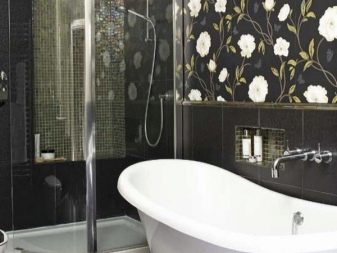
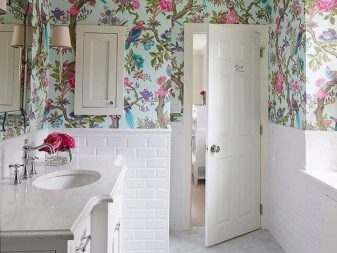
With PVC panels
PVC panels imitating tile have appeared on the market relatively recently. They can be used in combination with tiles to finish the bathroom in those places to which you want unobstructed access. For example, to cover the wall along which the pipes run, to hide them from view. Also, using this material will allow you to save money, because PVC panels are many times cheaper than tiles.
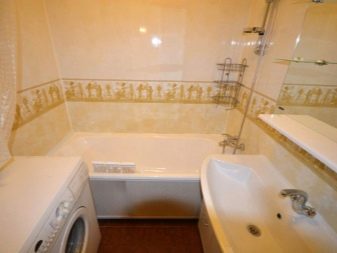
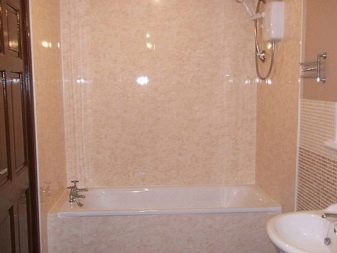
With wooden panels.
This is an expensive, but environmentally friendly material, which will appeal to followers of eco-style. The panels are treated with a special varnish, so they are not afraid of moisture, and the warm natural shades will provide a cozy atmosphere in the bathroom.

Very effective looks a combination of wooden panels with porcelain tiles, which can be used to clad the wall, which is adjacent to the bathroom or cheap cabin.
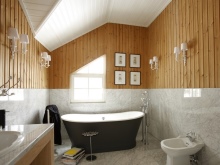

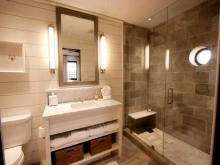
With decorative plaster
Decorative stucco trim is a new design trend that will showcase your impeccable taste. This decorative finish allows you to create incredible relief surfaces and hides small imperfections on the walls. But most importantly, you will be able to change the design of your bathroom without facing great difficulty. It will be enough just to remove the old plaster and apply new plaster.
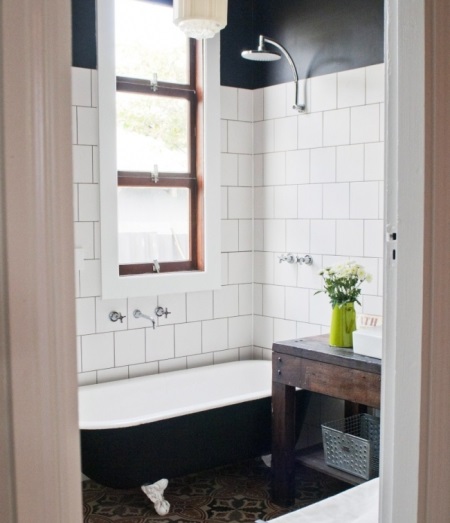
Decorative plaster combines well with tiles. As with the previous options, you can use tiles only in the bathroom area, and then apply decorative plaster. Additionally, it can be covered with enamel with nacre or acrylic varnish - everything is limited only by your imagination.
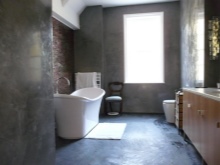
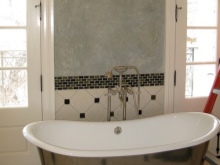
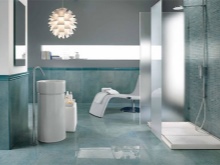
Popular colors
Most bathrooms can not boast a large area, so it is important to choose a color that will visually increase the space.
It is believed that the best color for this purpose is white, but this is a common misconception. It makes a room lighter, but it does not make most people feel comfortable. Therefore, white should be combined with other colors.
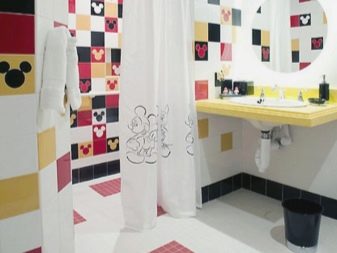
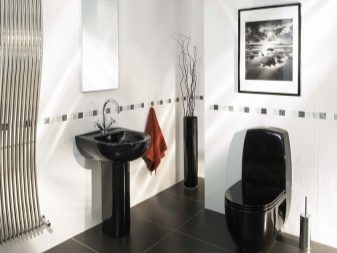
To decorate the bathroom, it is best to use colors from the green, yellow, or blue color palette, combining different shades with each other. Also very warm and cozy looks terracotta, light pink, beige, peach, ivory.
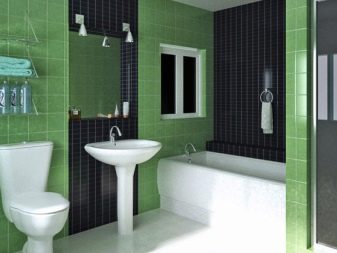
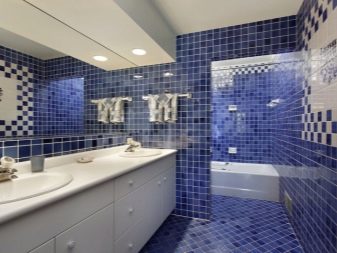
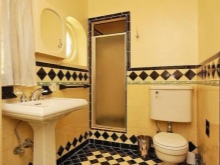
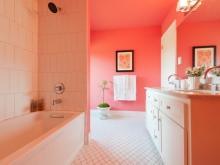
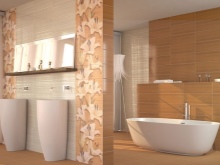
If you want to create an atmosphere of freshness and lightness, use cream, pearl, silver, lavender, sky blue. They will fill the room with light and give you positive emotions.
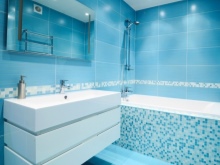
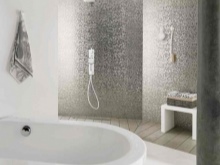
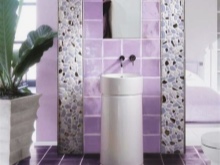
Combining colors
The combination of colors is appropriate in a bathroom that is larger than 2 km.m. In this case, a monochrome finish will look too boring.
Combine shades that are close to each other:
- lavender and pink;
- blue and blue;
- Chocolate and cream.
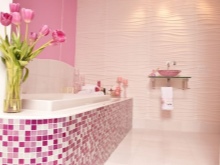
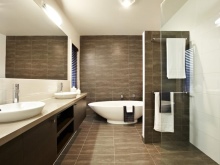
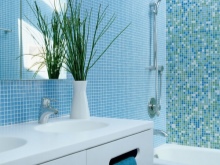
Playing with contrasts also looks great:
- yellow and blue;
- purple and yellow;
- Red and white.
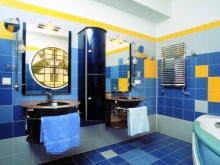
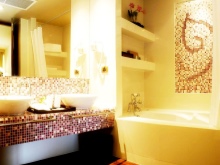
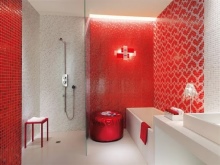
The smaller your bathroom, the less bright colors it should have. For example, all the tiles in the bathroom will be blue, and a few compositions in a scattering of yellow. You can make another horizontal line in the area of the sink or ceiling. The countertop can also be clad in a complementary color.
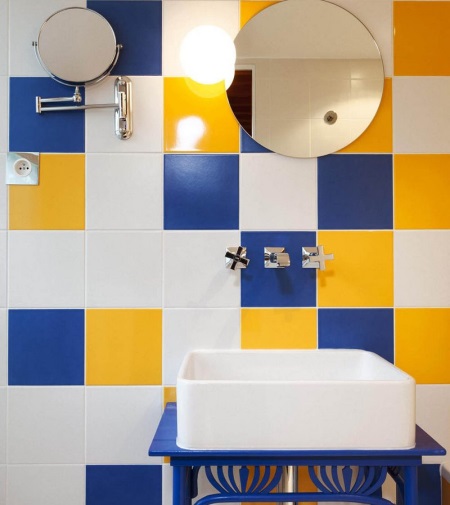
You may want to lay out some sort of ornament from the complementary color. For example, an African-inspired pattern would look great in a coffee-beige bathroom.

If you want to use not two colors, but three or four, give preference not to tile, but to a mosaic. Small mosaic tiles help to expand the space to such an extent that no mottled colors will be able to reduce it.
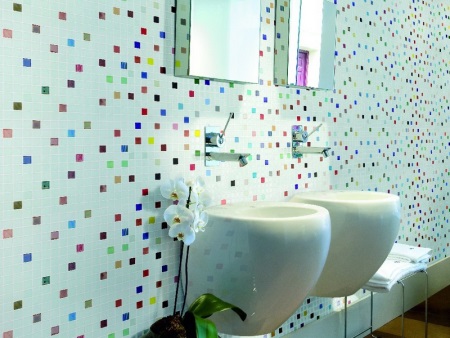
Remember the main rule: the floor should be darker than the walls, but the color of the tiles from the floor must be present somewhere else. It can be small flecks, stripes or patterns, which we wrote about above.
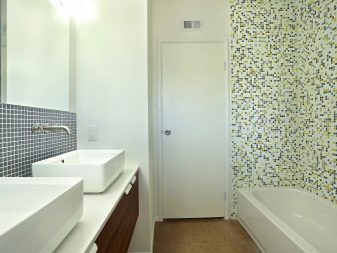
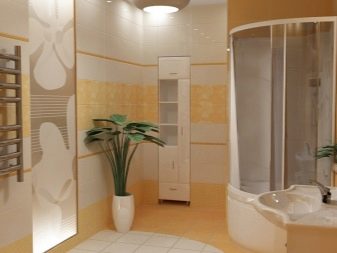
Laying options
Light top and dark bottom
This method of laying a tile can be called a classic, because it occurs more often than all the others. The advantage of this laying variant is that you don't need to think out the most successful tile layout and even calculate the necessary amount of materials. Everything will be done for you by the manufacturer and the sales consultant in the store.
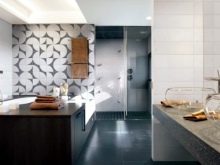


The disadvantage of this method of laying is that it visually reduces the space, even in spite of the bright top. Therefore, it is recommended to lay a vertical strip of frieze at the border between the two colors, which will expand the space back.
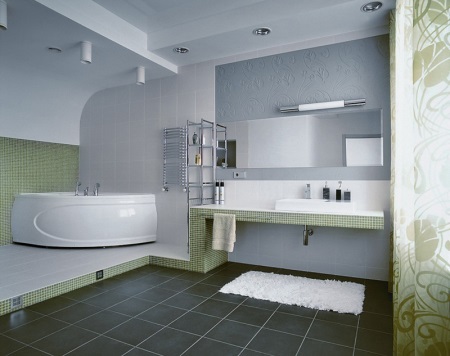
Diagonal laying
This variant of laying is rare today, so you will be difficult to find a master who can do it qualitatively and beautifully. It is quite a complicated technique that requires proper marking and the right start. The installer must be experienced enough to correctly lay the first diagonal strip, which will be the starting point of the entire job.

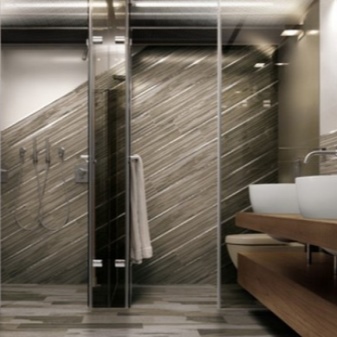
The main advantage of this type of laying is that diagonal strips visually make the room look wider and higher. In this case, you will need to abandon the frieze and any other clear accents.
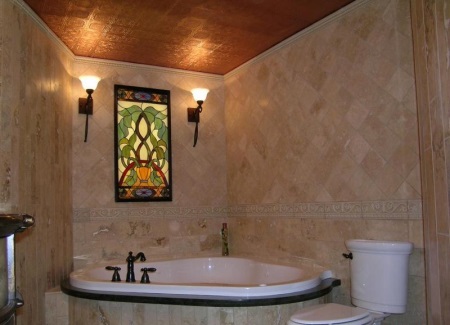
Combination laying.
A great option for larger bathrooms. Several ways of laying can be used at the same time: diagonal, straight, decoration with frieze, ornaments, panels and other decorative elements. But it should be not just individual motley fragments, but a clearly thought-out design.
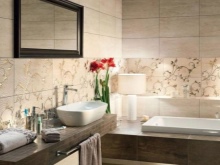
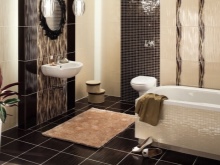
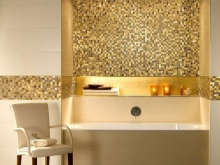
The most popular method of combined laying is a panel of tiles or mosaics. You can lay it yourself or buy it ready-made, which greatly simplifies the process of laying.

Checkerboard laying
You can guess from the name of this method of laying that the tiles of two or three colors are laid in such an order that the wall begins to resemble a chessboard. This method is suitable for both diagonal and conventional method of laying. One of the uncomplicated, but quite interesting options.
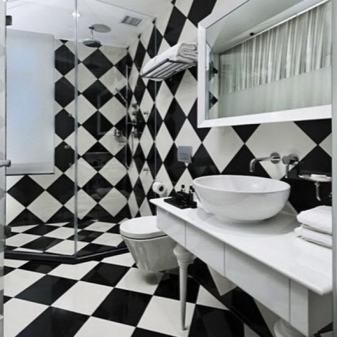
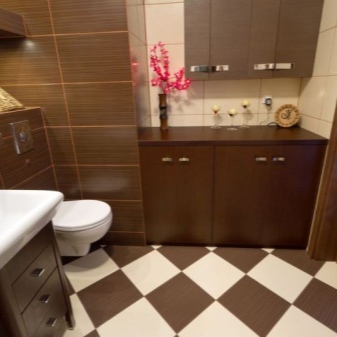
Styles
Eco-style
The main feature of eco-style is the use of natural natural materials, shapes, colors and shades. Only simple laconic forms, soft lines, indistinct geometry. Widely used plant materials: bark of trees, stones, shells and so on. Be sure to have a lot of living greenery!

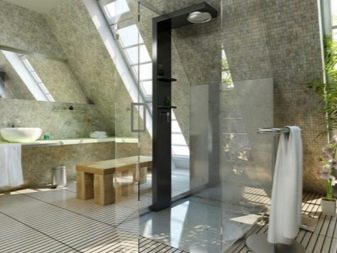
In this case, for wall cladding can be used porcelain tiles, wooden panels or bamboo wallpaper. Also suitable are ceramic tiles, made in a natural color scheme. The use of metal accessories should be kept to a minimum, replacing them with wood or stone.
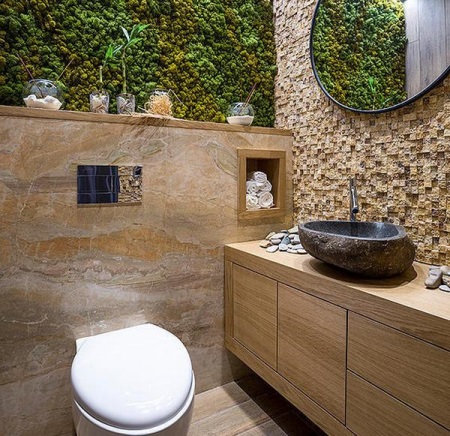
High-tech
The main feature of the style of high-tech can be called constructive, urban. That is, the maximum use of modern communications, technology and materials. Beams, supports, pipes and other details of structures serve as the main decorative element, they are usually exposed. Only modern materials - plastic, glass, metal - are used in the finishing work.
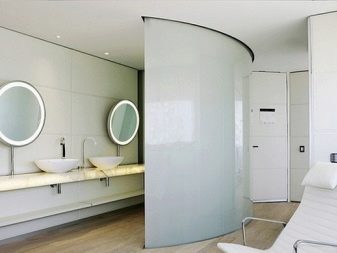
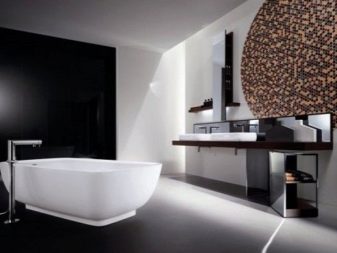
Your bathroom should have as many shiny surfaces as possible. If you use for wall cladding tiles with a thematic design, the ceiling can have a glass or mirror surface. The color scheme is urban: all shades of gray, black, silver. Inclusions of white, red and fuchsia are possible.
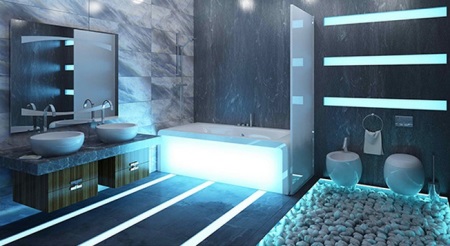
Scandinavian
The Scandinavian style can be described as "cozy minimalism". Everything is maximum restrained, but at the same time it is not deprived of nice and cozy details. The main features of the Scandinavian style are abundance of light and air, simplicity of design and use of natural materials.
Pastel, necessarily natural color scheme prevails, the main color is white, which is diluted with splashes of bright color accents. It is enough to have small neat elements - colored towels, laundry basket or a bright composition on the wall, using tiles.
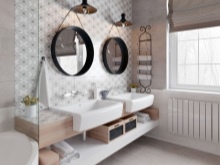
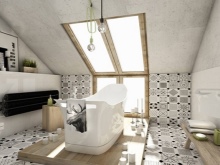
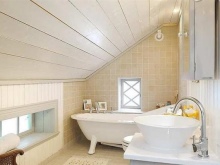
The entire bathroom can be tiled. For the walls use a light shade - ecru, beige, light gray, and on the floor you can put dark tiles imitating natural stone.
Be sure to have wooden elements, it can be a countertop or shelves for cosmetics. In your bathroom, there should be many sources of light, so do not forget about a large number of lighting fixtures.
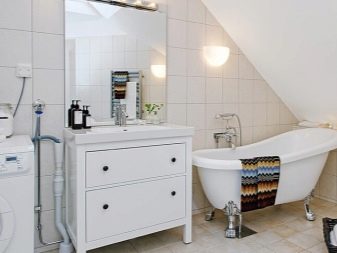
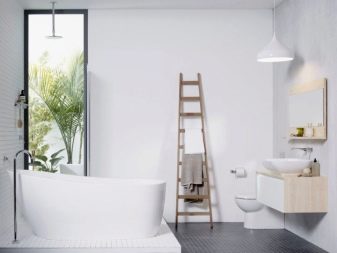
Provence
The style of Provence can be called the exact opposite of the style of high-tech. Its main distinguishing features are homely comfort, unpretentious design, warm colors and only natural materials.
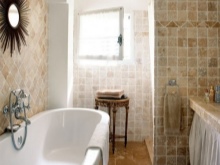
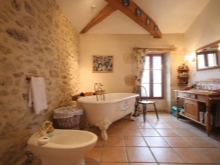
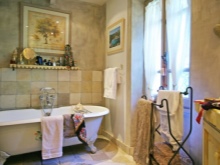
The walls can be tiled or covered with decorative plaster. It is possible to combine these two ways of finishing, as we wrote about above. The color of the walls should be calm - beige, milky, bluish or lilac. All colors should be muted matte.
The floor should be covered with ceramic tiles of a darker shade. In order to maximize the atmosphere of homeliness, install underfloor heating. The ceiling is best simply whitewashed or, if budget allows, lined with wood.
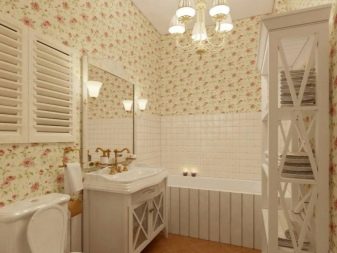
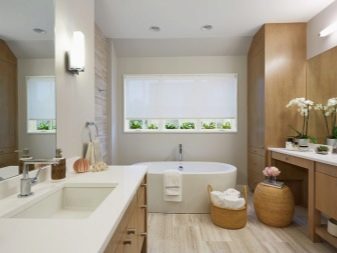
Decorating Tips
A Small Bathroom
Making repairs in a small bathroom, adhere to several rules:
- Install only soft light-colored surfaces;
- Use as many mirrors as possible, which will visually expand the space;
- Make a small niche in the wall, which will also make the room "bigger";
- Install as many lights as possible, which will fill the room with light and work to increase space.
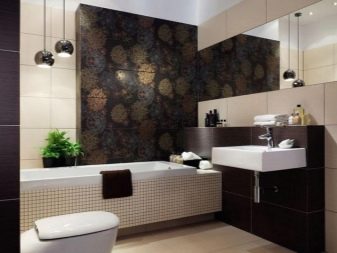
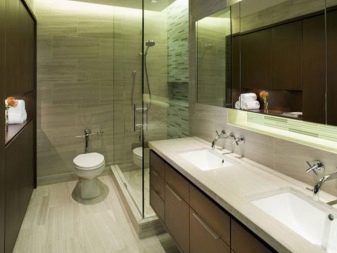
Spacious Bathroom
Furnishing a large bathroom is not easier than a small bathroom. To make the process easier, divide the room into zones. For example, install plasterboard partitions, tiled. They can separate the toilet, bathtub and shower enclosure from each other.

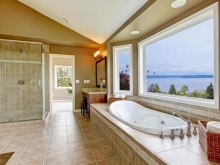
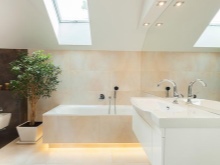
With more space, you have the option of installing bidets and paired sinks for spouses. There's also no need to choose between a bathtub and a shower stall, now you can install them separately. To make sure all family members are as comfortable as possible, make sure the bathroom is as comfortable as possible.
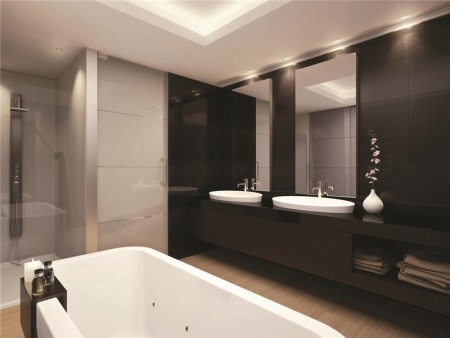
Tips for choosing tiles
When choosing tiles, it is important to consider its color and texture. If you have a spacious bathroom, you can afford tiles of large or medium size. It is much better than a small one in terms of moisture penetration and the formation of mold and mildew.
If you have a small bathroom, it is not rational to use large tiles, because you will have to cut them when installing. It is better to give preference to small tiles or mosaics.
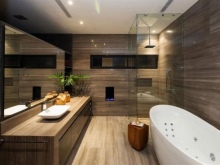
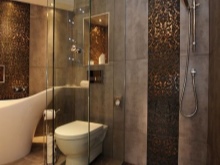
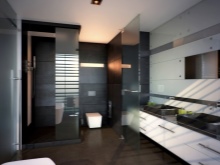
It is important to consider the color scheme of your chosen cladding material. Contrary to the widespread blue and blue colors, it can act on the psyche depressing. If you like to relax in a hot bath after a day of work, give preference to "cozy" beige and gold combinations.
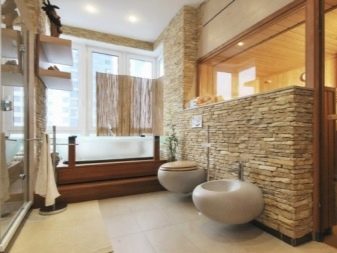
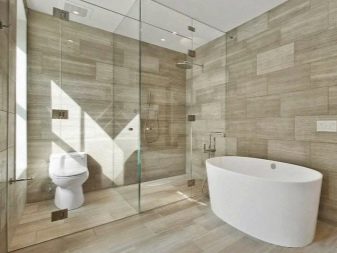
Today red tiles are in great demand, but keep in mind that they visually narrow the space. Use it in combination with white tiles to properly set accents. For example, use burgundy tiles to line the floor and add a red horizontal line near the sink.
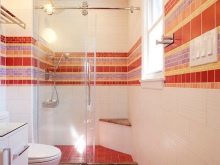
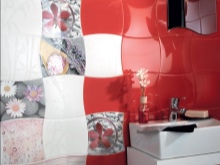
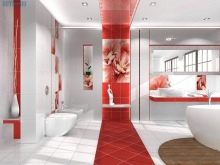
Here are some examples of this type of trim.
1. A successful example of the decoration of a small bathroom, combined with the bathroom. The wall, which is adjacent to the plumbing, is tiled in coffee tones, the darkest color of which is duplicated in the flooring. The rest of the walls are covered in light decorative plaster. A striking accent is the inclusion of mustard-colored tiles, located at the same level in a chaotic manner.
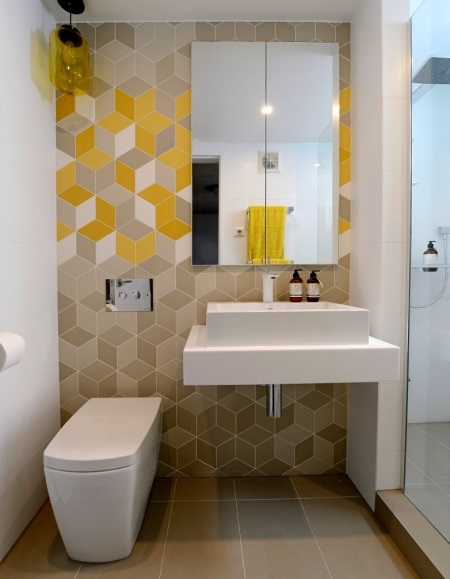
2. The small bathroom is filled with light to the maximum, thanks to the walls and ceiling of white. Wooden floors and properly placed accents of brass make the room cozy. Unlike the "cold" chrome faucets and towel holders, the brass looks warm and soothing. The graphite-colored bathroom gives the interior a touch of nobility and special charm.
